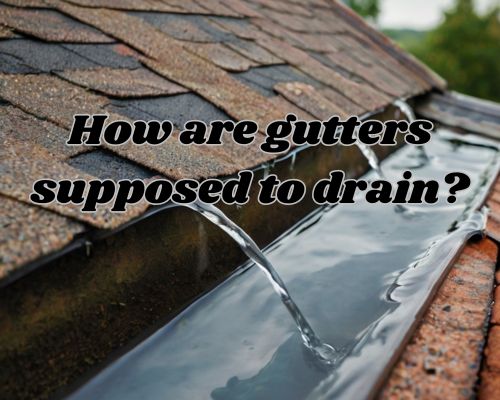
How are Gutters Supposed to Drain? A Complete Guide to Efficient Drainage
Gutters play a crucial role in protecting your home from water damage by efficiently directing rainfall away from your property.
The key to how gutters should drain lies in their slope and pitch, which guide rainwater towards the downpipes and away from the foundation.
“Proper installation ensures that water flows freely without pooling or overflowing, which can lead to structural issues over time.” said Steve Arnie of Gutter Cleaning Melbourne Co.

Understanding the correct slope of your gutters can save you from costly repairs.
A slight tilt towards the downspouts, typically 5 to 10 millimetres per 3 metres, is ideal to prevent stagnation and maintain effective drainage.
Measuring and adjusting your gutters correctly prevents common mistakes that can result in damage to your home’s exterior or foundation.
In addition to slope, attention should be given to the positioning of downspouts and the installation of extensions to redirect water flow.
This prevents splashbacks and helps avoid the development of mould and dampness.
With simple adjustments and regular maintenance, you can ensure your gutters function optimally, protecting your home from the elements.
Understanding Gutter Systems
Gutter systems are vital for channelling rainwater away from your home, preventing issues like water and foundation damage.
With Steve Arnie of Gutter Cleaning Melbourne Co., this section, you’ll find insights into gutter components, the importance of effective drainage, and best practices for installation and maintenance.
Components of Gutter Systems
A typical gutter system consists of various components ensuring efficient water flow.
Gutters collect rainwater from your roof.
Downspouts guide this water downward, preventing erosion around your foundation.
It’s often beneficial to incorporate downspout extensions to direct water further from the building.
Installing gutter guards can help in reducing debris accumulation, thus minimising the risk of clogged gutters.
Each part plays a role in maintaining the longevity of the system and protecting your home from water-related problems.
Importance of Proper Gutter Drainage
Proper gutter drainage is crucial in safeguarding your home from issues like foundation damage and soil erosion.
By efficiently directing water away, gutters help prevent flooding and protect landscaping.
Effective drainage reduces the likelihood of overflowing gutters, which can cause severe damage to roofs and walls.
Regularly monitoring the slope and pitch of your gutters ensures optimal performance.
Ensuring clear downspouts and functional drainage systems helps in avoiding potential water damage and maintains the structural integrity of your home.
Gutter Installation and Maintenance
Installing gutters correctly is crucial for ensuring effective water drainage.
Proper gutter slope allows rainwater to flow efficiently to downspouts.
Meanwhile, regular gutter cleaning is vital to remove debris and avoid clogs that can obstruct water flow.
Keeping an eye on potential issues like sagging or leakage will enhance your system’s longevity.
Utilising tools like rain barrels for water collection can contribute to water conservation.
By performing routine checks and maintenance, you ensure that your gutters continue to function as intended, providing vital protection against water damage.
Gutter Drainage Solutions
Effective gutter drainage is essential to prevent water-related issues like mould, basement leaks, and foundation damage.
Solutions enhance downspout efficiency, adopt advanced drainage systems, and present innovations in rainwater management.
Enhancing Downspout Efficiency
To ensure water is directed away from your home, downspout placement and extensions are crucial.
Downspout extensions help channel water further from your home’s foundation, minimising the risk of water pooling and potential basement leaks.
Meanwhile, splash blocks can be used at the end of downspouts to disperse water, reducing soil erosion.
Consider the use of roll-out drain sleeves for temporary extensions, which can guide rainwater into appropriate areas, such as a rain garden or swales.
This not only manages water flow effectively but also integrates neatly with your landscaping.
Advanced Drainage Systems
For more substantial water management, French drains and dry wells are excellent systems.
French drains use gravel-filled trenches with perforated pipes to redirect water underground. They are particularly effective against persistent water issues like pooling or soggy landscapes.
Dry wells, on the other hand, collect rainwater and allow it to percolate into the surrounding soil slowly.
Both these systems work hand-in-hand with proper gutter drainage to enhance your property’s water management capabilities, ensuring that stormwater drains effectively.
Innovations in Water Management
Innovative solutions like rain chains and seamless gutters offer both aesthetic appeal and practical function.
Rain chains replace traditional downspouts, guiding water down artistically. They can be integrated with rain barrels for water conservation.
Seamless gutters reduce the risk of leaks and potential mould and mildew build-up by eliminating seams that often become clogged.
Integrating swales and rain gardens further boosts the environment’s ability to handle excess rainwater.
These solutions enhance landscaping, funnel water efficiently, and support sustainable water management practices.
By implementing these advanced solutions, you can greatly improve your home’s drainage system and protect it from water damage.





